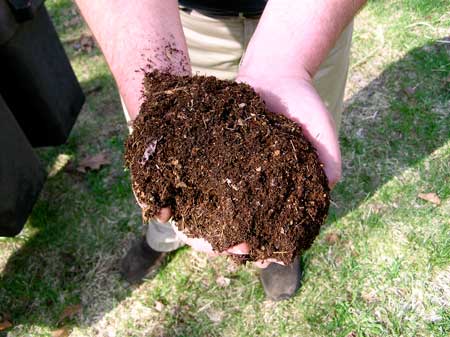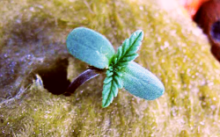You are hereMulch: Powerful Tool for Organic Growers
Mulch: Powerful Tool for Organic Growers
by Mulcher4Life
Introduction: Mulch for Organic Gardening
 In an organic setting, the goal or ideal method is to mimic nature in the most efficient way possible.
In an organic setting, the goal or ideal method is to mimic nature in the most efficient way possible.
Since, potentially, it is medicine for sick patients that we are producing, we must do our absolute best to make sure that it is free of any pathogenic fungi, mites, aphids, and any vectors that may present external diseases to our gardens and medicine.
In nature, there are beneficial predators that take care of these possible occurrences that are not found in a greenhouse or indoor setting, so cleanliness is of the utmost importance for the indoor organic gardener.
In attempting to follow the methods by which plants and nature, in general, have adapted to for millions of years, we find ourselves studying every aspect of its awe-inspiring, fully-sustainable cycle.
In this article, we will be discussing the first part of this cycle, or what we call mulch. It is an aspect of cultivation that is usually taken in a state of ambivalence and/or triviality, but there is much to gain from applying this technique to your organic garden, if done properly.
What Is Mulch?
Mulch is a layer of material that covers the soil.
If we look at the soil as a true living organism, mulch is like the epidermis (skin) of the soil. In old growth forests, nobody has fertilized, but yet we find the most abundant diversity of life. There is nobody that waters these forests, yet we find them to be adequately moist at all times. These insurmountable feats can be partially attributed to the simple layer of mulch that forms every season.
A layer of mulch is, by definition, a layer of material that covers the soil.
What does mulch do for soil?
- protects from elements that can harm the roots or microbial life
- insulates the soil from heat or cold
- potentially enriches soil with a form of compost
- can make nutrients and oxygen more available to plant roots or beneficial microbes
- reduces evapotranspiration (water evaporation from the soil)
In nature, mulch usually consists of leaves, small branches, and dead insects that are composted over winter in order to supply the soil with the nutrients necessary to sustain growth. By having this layer, the soil is shielded from intense light, which harms microbial populations near the surface.
This shield from intense lighting also allows for the roots to come just under the surface where the highest concentration of microbes are found and thus, nutrients, along with oxygen. Mulch also serves as a form of insulation from cold and heat extremes, which isn’t such a useful utility in an indoor setting if temperature is controlled, but can help in an outdoor setting during heated summer days.
The best advantage of using mulch, in my opinion, is the reduction in evapotranspiration from the soil surface, therefore allowing plants to obtain sufficient water needs during periods of drought.
In several studies by researchers at Texas A&M University, it's been concluded that the application of mulch on top of the surface of the soil reduces evapotranspiration by 25% or more, as compared to non-mulched soil counterparts. Some studies only measured the reduction of water needs due to evapotranspiration, but strong winds also play a major factor in drying out the growing medium, especially outdoors, so I would estimate a total of ~30-35% reduction in water usage by adding mulch outdoors. In a documentary, Back to Eden, the featured farmer claims he doesn’t water at all, and harvests the most nutritious and juiciest fruits that one can have, all due to mulching.
Mulch - Bacteria and Fungi
The type of mulch makes a huge impact on the efficacy of the technique. There is no one perfect type of mulch for all situations, but I will provide you with the information necessary to choose the best option to tailor your specific needs.
A knowledgeable gardener can use mulch to modify the type and rate of microbial life in the soil.
- Bacteria - Fresh, green organic material supports bacteria
- Fungi - Aged, brown organic material supports fungi
Fresh, green organic materials have primary cell walls that are made of cellulose, which is easily broken down by bacteria that secrete the enzyme, cellulase. This modification of microbial life can change the pH of your medium allowing certain nutrients to be more available.
Brown organic materials such as small branches, wood chips, twigs, etc. are products of secondary growth of plants; that is, they are woody. The cell walls from secondary growth are comprised of lignin, an amorphous polymer. Lignin is most easily broken down to its simple constituents by fungi that secrete the enzyme, ligninase.
Fungi prefer a more acidic environment while bacteria prefer one closer to 7. An increase in population of either organism will, consequently, alter the pH. A combination of both is necessary for cannabis in a true living organic setting, usually ending up at an ideal pH of 6.5; however, one can faintly tweak this by adding mulch that stimulates either bacterial growth or fungal growth.
Vegetative Stage
It can be helpful to boost bacterial growth during the vegetative phase alkalinizing the medium to 6.6-6.7, thus allowing more vegetative-friendly nutrients to be available to the plant. For example molybdenum acts as a nitrogen pump helping move nitrogen from the older leaves to the newer leaves, but is only available to the plant roots at a higher pH. Fresh green organic materials and mulch that has been worked into the soil tends to support bacteria.
Flowering Stage
During the flowering stage, one can incorporate a fungi-stimulative mulch to achieve a pH of 6.3-6.5 for improved inflorescence. This slightly lower pH while plants are budding allows better nutrient availability of essential macronutrients (such as Phosphorus and Potassium) and micronutrients. Aged, brown organic material and mulch which is laid on the surface of the soil tends to support fungi.
Taking Care of Microbial Life
Mulching, in a sense, is the same as composting with all the aforementioned benefits, so you want to make sure that whatever you use to mulch is something that is not damaging to the soil life or plants.
Make sure to stay away from anything that has been treated with dyes or paints for esthetic value. The most popular and reliable type of mulch used is composted and/or shredded bark mulch. It isn’t very pretty, but it’s useful. Always try to locate local composted bark mulch, preferably shredded, because it will cause there to be less decomposing of that mulch and will therefore preserve some of the nitrogen that would otherwise be temporarily unavailable to the plaint.
NOTE: Avoid anything from a walnut tree or cedar bark
If the mulch is not composted, you will need to make sure there is some extra source of nitrogen, such as alfalfa meal or blood meal, to stimulate the microbial life that will start decomposing the bark mulch.
Some growers apply an extra source of nitrogen right under the mulch every time because the mulch increases the populations of microlife. If the the microlife begins to run out of nitrogen, they will steal it from the roots, sometimes causing a premature nitrogen deficiency; however, too much nitrogen will cause a spike in microbial population growth at a logarithmic rate until all their “food” source is depleted and all the nitrogen is immobilized (stored) in the living microbes (unavailable to the plants) until they die and it becomes mineralized (available).
Alternate options for mulches include grass clippings and straw. Make sure grass is not sprayed with any herbicides/pesticides and doesn’t contain any weed seeds. Also, make sure to dry before applying. Fresh, green material may settle and form a dense mat or produce an unpleasant odor which indicate anaerobic conditions.
Organic mulches can harbor weed seeds, disease organisms, and insect pests. To make sure that the source you’ll be using has no uninvited hitchhikers, you can sterilize it by baking moist mulch in a foil-covered pan/sheet at 225* for 20-30 minutes. (This can't be done with straw)
Adding Mulch to Your Soil
Application: a mulch layer of 1”-3” is ideal. If also using compost, add a thin layer of compost or worm castings under the mulch layer to mimic layers of soil found in nature.
Rules To Remember
Bacteria
- greens = bacteria
- more shredded = more bacteria
- mulch is more worked in to surface = more bacteria
- the wetter the material (up to a certain point; definitely not too moist) = better for bacteria
- boosting bacteria makes pH go up (no more than 6.6-6.7 is recommended) - better for vegetative phase
Fungi
- browns = fungi
- less shredded = more fungi
- mulch is laid on top of the surface = more fungi
- mulch is less wet (up to a certain point; definitely not too dry) = more fungi
- boosting fungi makes pH go down (no less than than 6.3-6.5 is recommended) - better for flowering stage

Mycelium Fungi Growing in Mulch - Source: waldeneffect.org
Jump to...
How do I grow organic marijuana?
"Main-Lining" Tutorial by Nugbuckets: Train Marijuana Plants for Bigger Yields
Should I grow plants indoors or outdoors?





